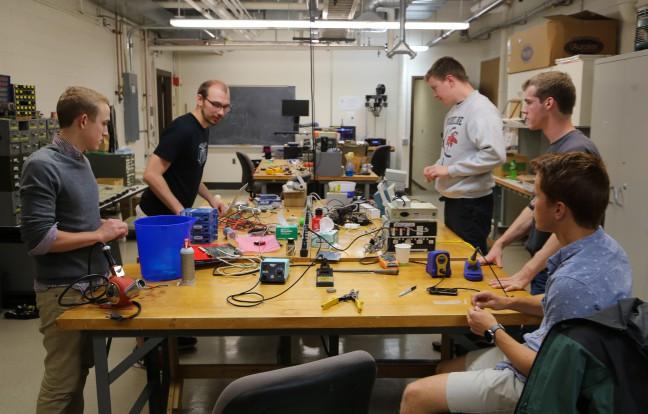In lab B613 beneath Sterling Hall, dozens of students are working to create their own experimental machines with the help of physics professor Duncan Carlsmith and the Garage Physics program.
Supported by the University of Wisconsin physics department, Garage Physics provides an unstructured lab environment with the necessary resources students need to create their very own prototype. The program has facilitated a range of projects, from a balloon measuring cosmic radiation and a mind-controlled quadcopter, to more practical ones such as a device to monitor weightlifting form.
Brett Unks, a program facilitator, said the Garage is currently working on projects including a watt balance with an extremely precise scale and an advanced tool used to cut material. Unks procures material and equipment for Garage users.
The Garage is a dense sprawl of workbenches, tools and wires attached to a neat office with chalkboards and desk space for project planning. Ian Wisher, a graduate student and lab assistant, said that unlike Carlsmith, he focuses more on developing useful skills students will need to create devices later on.
Wisher focuses on the technical skills students need if they wish to become graduate students in the physics department or plan on working on projects following graduation. So, students participate in workshops where they learn soldering techniques, wiring skills and mathematical projections.
Wisher said right now, students are working on a Fizeau-Foucault apparatus, a device used to measure the speed of light. He said the project is useful as it has many different components requiring different skills.
“There’s a data acquisition part, an optics part [and] a mechanical part, so it has the range of different skills required to actually build a full experiment,” Wisher said.
Any UW student can use the facilities to pursue any project they wish and are also encouraged to form interdisciplinary entrepreneurial teams, Carlsmith said. The program provides research and development support leading up to possible business opportunities for these teams, he said.
Some of the projects that have come out of Garage Physics have already evolved into viable business endeavors.
Daniel Litvak, a senior at UW, used Garage Physics to help him realize his idea for a workout monitor. He said he joined the program in January by himself and was able to create a working prototype for his startup business, Weightup Solutions. Through the program he was awarded a $1,000 grant to help acquire the material he needed.
Having a prototype helped Litvak get accepted into the gBETA program run by the startup accelerator Gener8ator, which provides free mentorship to early stage Wisconsin startups.
Litvak said the equipment and space provided by the program were helpful, and he met with Carlsmith almost weekly during development.
“He provided guidance on different ideas on how to accomplish tracking weightlifting,” Litvak said. “[There are] different ways of going about it, from using an Xbox Kinect, accelerometer or magnetometer.”
He said his product provides information on how form changes during different points of a weightlifting workout through wearable hardware. It can also track balance information, such as which arm is being favored during a benchpress set.
Two companies were launched through Garage Physics last spring, according to Carlsmith. He said they were supported through mini grants, such as the one received by Litvak from VentureWell, which works to promote science and technology inventions.
Other projects facilitated by Garage Physics include a high altitude balloon which used an app to measure the flux of cosmic radiation, 3D printed instruments, a methane digester and a 3D scanner.
The program started in 2014, and current projects underway include cell phone-based virtual reality and a smart mirror.
“Teams explore a project and not just try to build something fun, but also see what kind of value it has,” Carlsmith said.


